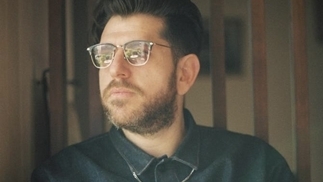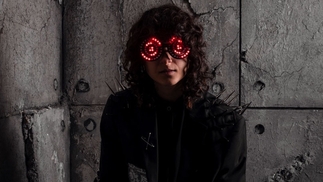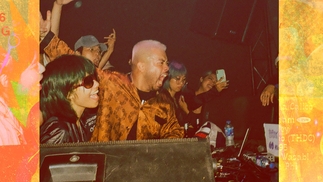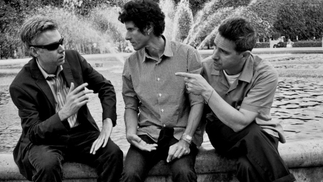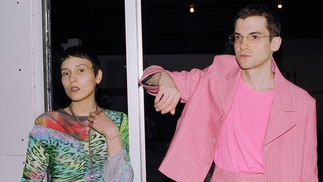Red Axes: "The most important thing in this work is your personality"

With a punk attitude, impressive live shows, and an ever-shifting psychedelic yet dancefloor-friendly sound, Red Axes have brought a breath of fresh air to the electronic music scene in recent years, all while avoiding the typical indietronica clichés...
"When the sun is shining, life can be really dark,” says Dori Sadovnik, one half of Israeli gothic dance duo Red Axes. He’s talking about the origin of the group’s shadowy sound. “Actually, when the sun is shining, and you feel not so good, it’s better to have rain.”
Dori Sadovnik and Niv Arzi are Red Axes, and their moody assemblages of acid, EBM, spiky post-punk and garage rock have caused a serious upset in the last few years. Recording for many of the best labels in dance music, from Jennifer Cardini’s Correspondant to John Talabot’s Hivern Discs, Disco Halal to ESP Institute, their strobe-lit beats, haunted by the phantasms of leather-clad ’80s synthpop and industrial, have been much in demand.
That they make this doomy clamour is a little more surprising when you learn that they come from Tel Aviv. The city may be in the midst of the political tensions of the Middle East, but it’s also a place where the sun blazes continually: a tourist destination with stunning beaches and a sizeable club scene, and venues pumping out sleek house, techno and trance to an ever-eager crowd of punters. “The darkness, it’s there, it doesn’t matter if you’re in a sunny place,” says Sadovnik. “When you have this super-heat and you’re feeling like shit, it’s worse.”
It was their dark edge that appealed to DJs when the band broke through in 2013 with the murky disco-punk piece ‘Caminho de Dreyfus’ featuring the vocals of Abrão Levin: a startling track with a thumping bassline and squalls of jagged guitar. It fit right into the sets of Andrew Weatherall, Man Power and Jennifer Cardini at the time and, after the 2014 album ‘Ballad Of The Ice’ on I’m A Cliché, they became ever bigger, with appearances for Boiler Room, live shows at such diverse festivals and clubs as Glastonbury, Sónar, Berghain, Pacha, Burning Man and Field Day, and even their own Garzen festival (named after their record label). “We started out playing for 100 people, 300 people,” says Sadovnik. “Then it grew and grew; then it was for 1,000, 5,000 people. The sound has changed a bit: it’s a bit more high-energy. We really enjoy it.”
Central to Red Axes’ appeal is their straddling of worlds, mixing punk attitude, songs and guitars with credible dance beats and instrumental, purely electronic tracks aimed directly at the floor. While their rock tendencies are often on display (they covered ’80s arch goth band Bauhaus’ ‘Bela Lugosi’s Dead’ on ‘Ballad Of The Ice’), there’s a consistent inventiveness to their sound which avoids tired and obvious ‘indie dance’ clichés. Every track is loaded with weird sonic artefacts and mechanistic touches, sometimes using guitars purely for textural effect rather than just riffs. Their second album, last year’s ‘The Beach Goths’, bridged this gap more than ever, with a live sound incorporating drums, bass and lead guitar in addition to their usual electronic trickery. Some tracks, ‘Shlomit’ among them, were out-and-out rock instrumentals; some were jagged, psychedelic songs; ‘Shir1’ pulsated to a Giorgio Moroder bassline. The record’s title was a humorous reference to their dissonant mixture of influences, and the strange disconnect between the sinister EBM sounds they make and the sunny location where they live. “One time we played with Ivan Smagghe, four or five years ago, and it was his first time in Tel Aviv. He just called us beach goths,” says Arzi.

But there was a further connection. “It was very weird, the situation with the name,” he continues, “because after we released the record, I saw that there was another band that is quite big, The Growlers, and they called their first album ‘Beach Goth’, and they also have a festival of that name. What is funnier is that I was influenced by all this kind of garage rock. I didn’t notice The Growlers so much at the time. Without even trying to take something, we took something from another band.”
It sounded like the work of a full live band but, apart from the contributions of guests such as Iñigo Vontier, Gabriel Broid and Adi Bronicki, it was mostly the creation of Sadovnik and Arzi themselves.
“For ‘The Beach Goths’, it was just the two of us,” says Sadovnik. “Our studio is mostly based on lo-fi techniques and playing, exploring with our equipment. We just did it like that. If we wanted to have some live drums or some other instruments, we’d just book the studio and record them then.” Despite being well received by fans and critics (“I’m really happy with the feedback that we got from the electronic world for this album,” Sadovnik says),
‘The Beach Goths’ had a disadvantage: it was hard to play live. Though they put together a band and played it out for a while, it’s proven unsustainable. Their current live act is a more stripped-down affair. “The live show before was trying to go back to rock & roll, because we were playing bass and guitar,” Sadovnik says. “It was fun, but it was a bit too much pressure and it took too much time to do everything. Now we’re focusing more on electronic stuff. We bring the drummer from the start of Red Axes and we play synthesisers.”
Also released last year, Red Axes’ ‘NYX Tape’ EP for San Francisco’s excellent Dark Entries label (named after a Bauhaus song, of course) found the duo diverting back into avowed electronic terrain, collaborating with vocalists on one side and re-editing forgotten ’80s synthpop nuggets on the other. The title track combined a frosty vocal from German electropop chanteuse Gina X (of ‘No G.D.M’ notoriety), a one-note darkwave bassline, and shivery synths, while ‘5 Mins’ with C.A.R was a swerve into dark electro-funk mastery.
If these tracks showed a greater club focus, their latest release for Erol Alkan’s Phantasy Sound imprint, the ‘Sipoor’ EP, is another indication of Red Axes’ renewed dance oor direction. ‘Bad Time Story’ has a bassline reminiscent of Vince Clarke’s classic re-lick of Happy Mondays’ ‘Wrote For Luck’, before a tunnelling acid sequence enters the party, and a spooky string line descends like a miasma; ‘Teroof’ samples whizzing Formula 1 cars over its EBM beat to rush-activating effect. ‘Sipoor’ itself is an acid-dipped chug of oscillating 303 lines, threaded through with old school drum machine metronome sounds, train engine noises and crisp beats, with a decidedly heady vibe, designed for DJs and dancers. “When we started our label Garzen, I was super-hooked on the band sound and playing rock & roll, stuff like Butthole Surfers, it came to me again very strongly,” says Arzi. “I fell in love with it again. But now the main influence has changed. Most of our singles are more electronic and more DJ-oriented anyway, more than our albums.”

Wrapped around Sadovnik’s spoken vocals, delivered in a mixture of English and Hebrew, ‘Sipoor’ passes comment on DJs who are asked to ascribe meaning to their DJing in interviews with the music press. For Red Axes, DJs play out to make people dance and express their individual creativity, not to create pretentious odysseys. “‘Sipoor’ means story,” Arzi says. “All the time, DJs are asked in interviews or whatever, ‘How was the set?’ It becomes all about how the DJ tells a story. It’s funny to me. I think the most important thing in this work is your personality. That’s what people follow and get attracted to. The story? Everything can be a story. For me, this song is kind of ironic and a parody. The vocal is super-funny and in your face. It says something like: ‘I am trance, I am house, I am techno’, in a repetitive way. In the chorus it says something like, ‘This tune is going to be played in the club, so get the fuck out, fuck off’. It’s a joke, in a good way.”
Sadovnik and Arzi met while they were teenagers, and quickly recognised a kindred spirit in one another. “I can remember the first time I met him, I had a house party, and my parents went away,” says Arzi. “I used to invite everybody to hang out and listen to music. Dori came with one of my friends. I saw that he knew how to play guitar and I knew how to play guitar, so we jammed together a bit, and we wrote a couple of funny songs. That’s how our friendship started.”
Their first band, Red Cotton, was formed quickly afterwards, in uenced by gloomy post-punk bands such as Joy Division, the electropop of Kraftwerk and Yellow Magic Orchestra, and Israeli punk bands of the ’80s. But it was when Sadovnik and Arzi went to live in Amsterdam, leaving Red Cotton behind, that they discovered club music for the first time.
“We were 22,” remembers Sadovnik. “We started listening more to Tiga, Daft Punk, Justice, Boys Noize. It was back in the days [laughs]. I started to produce, Niv started to DJ more, and we started this thing called Red Axes. It was almost 10 years ago.”

''The dance thing we discovered in Amsterdam,” adds Arzi. “We already knew a little bit about it, and we started to get excited. We knew that in Amsterdam we were going to discover it more and more. It had a very strong impact.”
Although they learned about dance music elsewhere, Red Axes feel that their home city has had the biggest influence of all upon them. It was through DJing in Tel Aviv that they honed their sound. “It’s been huge, because we played here so much in the first years we started to DJ,” says Sadovnik. “We played three, four times a week sometimes. Long sets. Every time it was five hours, four hours, sometimes more. This was the school, you know?”
For Arzi, it’s the city’s diversity of cultures — people of the Jewish diaspora across the world who have come to live in Israel — that has made the biggest impression upon him.
“When you grow up with all the cultural differences, with all the children of immigrants that came from all over the world just like 70 years ago, more or less, culture is such an important thing,” Arzi says. “Everybody brought something else from a different culture. One is inspired and is listening to Arabian and Moroccan jams that their parents were listening to, and others listen to more classical and European stuff; some people came from Russia with all the strong Russian culture. All of this mixed together with the political situation and the environment and the heat, it’s a different place.”
Tel Aviv produced its own punk and electronic scene in the 1980s, and a new compilation by Red Axes, ‘Safety Pin: Obscure Sounds From Tel Aviv’s Noisy ’80s’ aims to shine a light on this little known period of musical history, which inspired the band. “In the ’80s there was a very strong wave of experimentalism,” Arzi says. “It’s a small city, but there were clubs, and people expressed themselves. This compilation shows a lot about where the music in Israel came from, and where it’s going too.”
Beyond their latest EP and compilation, Red Axes are focusing on their Garzen label, and have releases upcoming from The White Screen and their drummer Udi’s solo project. They’re especially proud to have signed female duo Deaf Chonky.
“The last EP that came out was by Deaf Chonky, with a Manfredas remix. I really like this record,” says Arzi. “It’s a band we discovered, two girls, they’re now 20. They’re super-talented. The girl that sings, Adi Bronicki, also sings on our album on the last song, ‘Into Your Arms’.”
The next step for Red Axes is an even more ambitious project, which has taken them far from their musical comfort zone. ‘Trip’ is their new concept: a series of EPs and accompanying films documenting their travels around the world, collaborating with local musicians.

First we have our ‘Africa’ EP,” says Sadovnik. “We went to do two gigs in Africa, and we did three tracks with recordings of people from Ethiopia and a band from Ivory Coast. Then we went to a school in Ivory Coast for music and art, and we did music with the children there who were 15, 16 years old. This EP is going out on !K7 Records. It’s going up with a 20-minute movie about the trip. Next we went to India with a camera, and recorded another movie, and recorded artists and music. This is really exciting for us. Every EP is a different place. We’ll see what’s next.”
Their new concept might not be the gothic racket fans expect from Red Axes but, says Arzi, they’ve always been experimental, and refuse to be governed by convention. “We try to forget all the rules. If somebody forgets that, we try to say to each other that it’s important to stay free. The most important thing is to just create and be honest with each other.”
This idea of freedom makes a lot of sense from a punk perspective: Red Axes might be goths, but they can break the rules and crack a smile once in a while.
